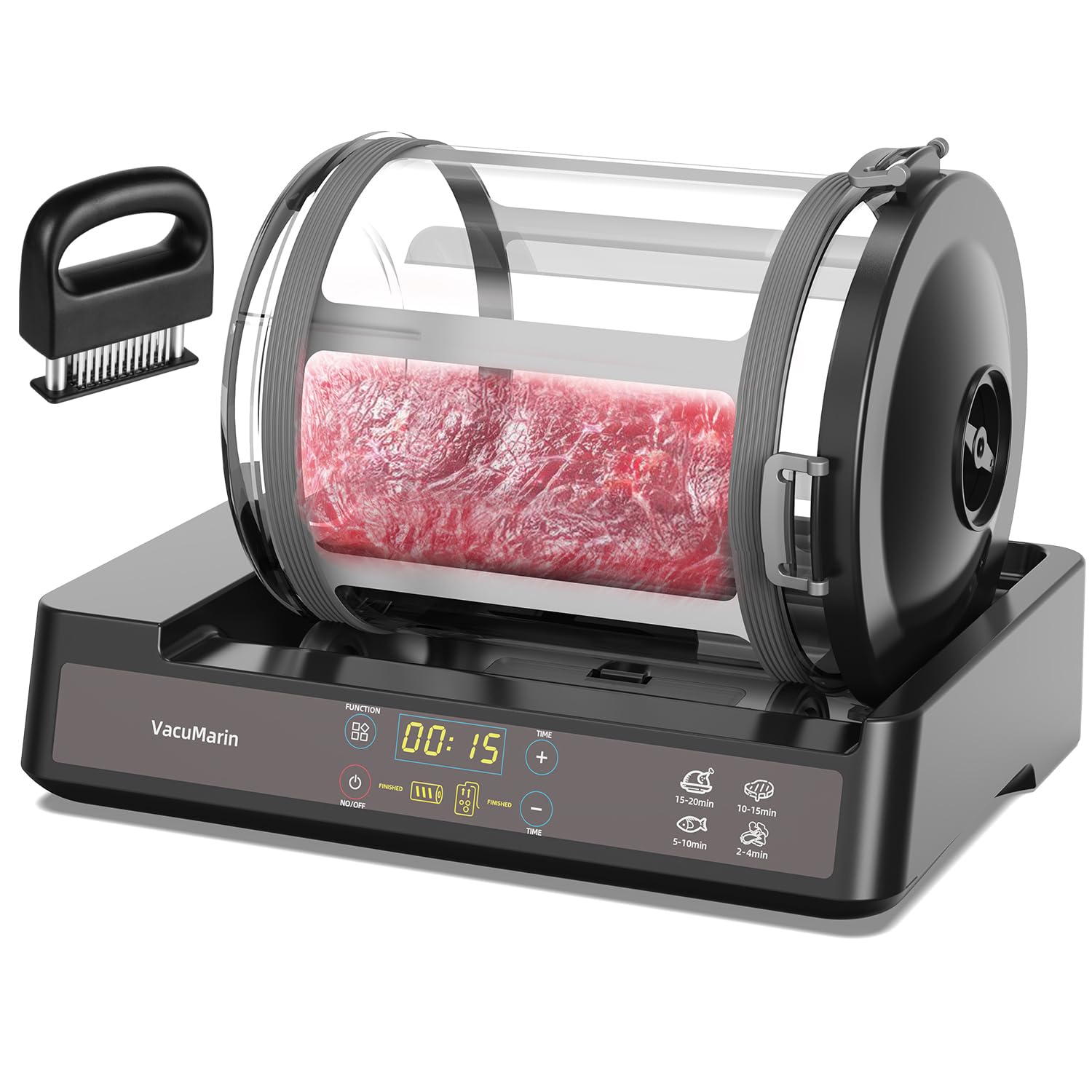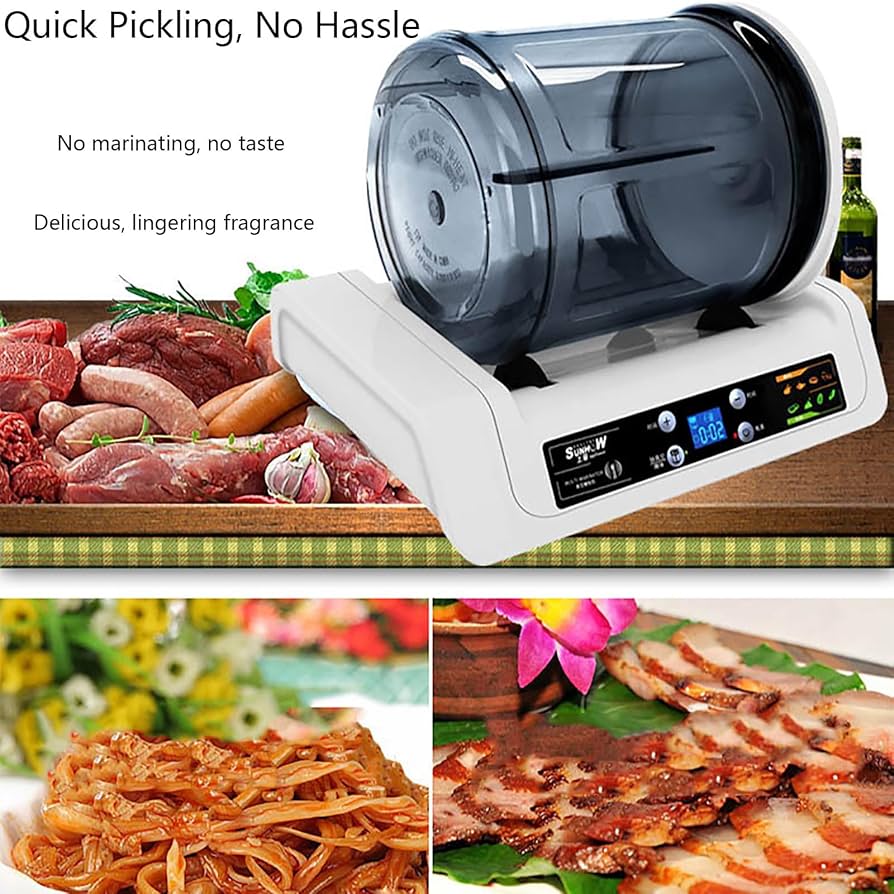10 years of experience as a food machinery equipment manufacturer
10 years of experience as a food machinery equipment manufacturer
The culinary world is constantly seeking innovations that enhance flavor, improve texture, and streamline preparation processes. One such technological advancement that has garnered attention in both commercial and increasingly in domestic kitchens is vacuum tumbling for marination. The Marinade Master Vacuum Tumbler is an example of a device designed to leverage this principle, aiming to optimize the marination process for a variety of food items.

Traditional marination methods, which typically involve soaking food in a seasoned liquid for extended periods, rely on passive diffusion for flavor absorption. While effective, this process can be time-consuming, sometimes requiring hours or even overnight soaking to achieve desired results. Vacuum tumbling introduces a more active approach to this age-old technique.
The core concept of vacuum tumbling involves two primary actions: the creation of a vacuum environment and the mechanical tumbling of the food within that environment. When a vacuum is pulled within the tumbler’s drum, air is evacuated from the chamber and, significantly, from within the porous structures of the food itself. This expansion of air pockets and muscle fibers can make the food more receptive to the marinade.
Once the vacuum is established, the tumbling action begins. The gentle, continuous rotation of the drum ensures that all surfaces of the food are consistently exposed to the marinade. More than just even coating, this mechanical agitation can help to further work the marinade into the food. The pressure differential created by the vacuum helps to draw the marinade into the spaces previously occupied by air. This combination of vacuum pressure and mechanical action is reported by users to significantly reduce marination times compared to static soaking.
Devices like the Marinade Master Vacuum Tumbler typically incorporate several features designed to optimize this process. Understanding these features can provide insight into their potential utility:
The primary advantage cited for vacuum tumbling technology is a significant reduction in marination time. What might take several hours or overnight with traditional methods can potentially be achieved in a fraction of that time, often within 20 to 60 minutes, depending on the food type and thickness. This efficiency can be particularly beneficial in fast-paced commercial settings or for home cooks looking to prepare flavorful meals more quickly.
Another frequently noted benefit is enhanced flavor infusion. By actively drawing the marinade into the food, vacuum tumbling can lead to a deeper and more uniform distribution of flavor throughout the product, not just on the surface. This can result in a more consistently seasoned and savory end product.
Improved tenderness and moisture retention are also commonly associated with this method. The mechanical action of tumbling can help to break down tougher muscle fibers, contributing to a more tender texture. Furthermore, because the marinade is drawn deeply into the food, it can help to retain moisture during the cooking process, potentially leading to juicier results.
The even coating provided by the tumbling action ensures that every part of the food item is exposed to the marinade, eliminating concerns about uneven seasoning that can sometimes occur with static marination if the food is not periodically turned or agitated.
While vacuum tumblers offer several potential benefits, there are considerations for their effective use. The type and cut of meat, poultry, or seafood will influence the optimal vacuum level and tumbling time. Denser, tougher cuts might benefit from longer cycles, while more delicate items require gentler handling and shorter durations. The composition of the marinade itself can also play a role; for instance, marinades with high acidity might require shorter tumbling times to prevent a mushy texture.
The capacity of the unit, such as the Marinade Master Vacuum Tumbler, should align with the user’s typical batch sizes. Overfilling the drum can impede the tumbling action and reduce the effectiveness of the marination process. Conversely, consistently underutilizing a large-capacity unit might not be the most efficient use of the appliance for a small household.

Maintenance, including regular cleaning of the drum, seals, and vacuum components, is essential to ensure longevity and hygienic operation. Users should familiarize themselves with the manufacturer’s recommendations for cleaning and care.
When compared to traditional marination, vacuum tumbling presents a more active and controlled approach. Static marination is largely a passive process, relying on time and the natural porosity of the food. Vacuum tumbling, by contrast, employs mechanical and atmospheric pressure changes to expedite and potentially enhance this process. It represents a technological step forward, aiming to provide more consistent and rapid results.
For individuals and establishments that frequently marinate foods and value efficiency, consistency, and depth of flavor, a device like the Marinade Master Vacuum Tumbler could be a worthwhile consideration. It addresses the common challenge of lengthy marination times and aims to deliver a more thoroughly infused product. As with any specialized kitchen appliance, its value is ultimately determined by the user’s specific needs, frequency of use, and the importance they place on the enhanced outcomes that such technology can offer.
In conclusion, vacuum tumbling technology, as exemplified by products like the Marinade Master Vacuum Tumbler, offers a systematic and potentially more efficient method for marinating various food items. By combining vacuum pressure with mechanical agitation, these devices aim to reduce marination times, improve flavor penetration, and enhance the texture of the final cooked product, making them an interesting option for culinary enthusiasts and professionals alike seeking to optimize their food preparation techniques.
